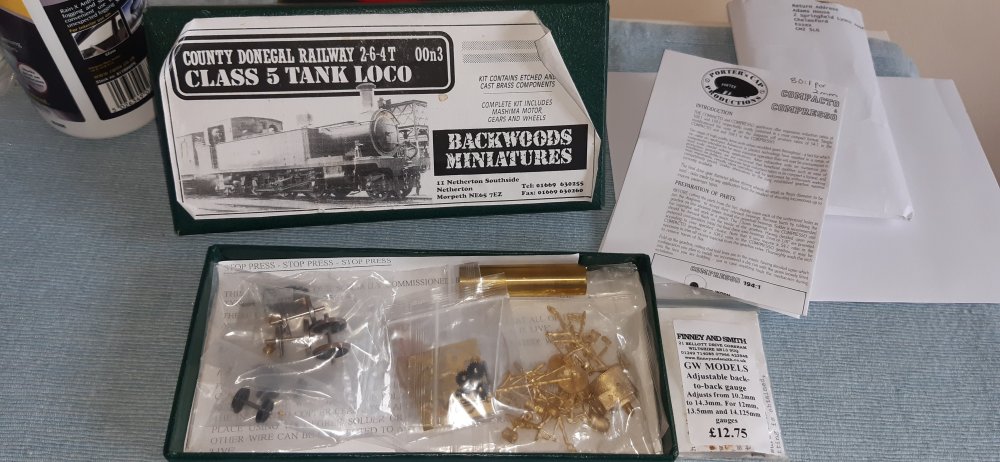-
Posts
2,296 -
Joined
-
Last visited
-
Days Won
4
Content Type
Profiles
Forums
Events
Gallery
Everything posted by Horsetan
-
The driving wheels supplied in the Class 5 kit appeared to be 16mm Romford / Jackson on extended plain-ended axles, nowadays Markits. I found them a bit too coarse for my liking, and replaced them with some plain 4' diameter Sharmans. The pony and carrying wheels were plastic-centred (or at least the ones in my kit were) and I thought they looked like Kean Maygib. Being spoked, they're wrong anyway, as the real things had disc wheels with holes drilled around the perimeter. Modern equivalents could probably be Markits, but they wouldn't be cheap nowadays. The other alternative might be wheels supplied by the 3mm Society or maybe 3SMR, as they work to 12mm gauge anyway. 3mm Society list - see pages 18 and 19 for wheels 3SMR wheels price list
-
The range was taken over by N-Drive about five years ago, possibly longer than that. Based on rate of progress, it will be another 5-10 years at least before we see anything like the full line of kits available again. That's not forgetting the OO9 (non-Irish) range - extensive in itself- is supposedly to be resurrected as well. Long wait.
-
This is a OOn3 (not actually TT gauge, even though it uses 12mm gauge track) model of the CDR's Nasmyth-Wilson Class 5 2-6-4T no: 6 Columbkille. The real thing still exists inside the Foyle Museum in Derry. Built from the long unavailable Backwoods kit, there's a bit of damage /distortion to the central buffer at the front - should be level, not pointing upwards. Rivetted smokebox is correct for no.6. Does it run?
-
Ernies Massive Irish 1930's to 2005 Photo Archive
Horsetan replied to Glenderg's topic in Photos & Videos of the Prototype
Note also the miniature semaphore used as a shunt signal. There was another one beyond the north end of the platforms, governing exit from the transhipment sheds. Strabane seems to have been the only place where mini semaphores were used at ground level. The condition of the perimeter of the mixed gauge wagon turntable suggests the GNRI used it rather less than the CDRJC! -
It'll polish out.
-
Give it 5-10 years. We should see the original range back by then.
-
I guess now yer man's stopped posting - possibly for good - you are actually getting something different to the "same old". Unintended consequences, etc.
-
He's kept that quiet, then, as his website doesn't mention that. We're still a good few years from seeing the rest of the Backwoods Irish range coming back into production.
-
Seems not.
-
The only way is
-
Alan Gibson's 4S44C bogie wheels are the closest equivalent, in that case.
-
The buffers aren't a problem - there are loads of oval-headed (and sprung!) options out there that will substitute adequately. Handrails should be easy to fix - there's enough of the intact ones left to replicate them with something other than fragile plastic. Damaged bodywork - well, I can see some paint marks, but the photos aren't close enough to give any other clues about the seller's drop-kicking skills. If it still runs well after all that, then it runs.
-
Maybe an outsize Amazon cardboard box containing several smaller Amazon boxes might do the business of adequately protecting it?
-
Seller is in Germany. His auction description, roughly translated, reads: "Locomotive runs in both directions Light change red / white Prepared for digital operation 21P decoder Light traces of glue from attaching the railings. Only used in test operation. Further accessories, manual and box." Photos suggest not a great deal wrong with it. It might actually run perfectly. May only need a DCC blanking plug, so. 13 Euros to post form Germany to Britain. Might be alright to convert to 21mm gauge.
-
Ernies Massive Irish 1930's to 2005 Photo Archive
Horsetan replied to Glenderg's topic in Photos & Videos of the Prototype
It could only have been better if it was Father Jack's favourite brand: "R's Biscuits" -
If there is no recording in existence, we'll never know what the original sounded like
-
That's promising. I wonder if they'd be correct for the one that's been rotting away in the Clifden Station Hotel complex for a few decades?
-
The bottom one is more towards purple.
.png.c363cdf5c3fb7955cd92a55eb6dbbae0.png)





